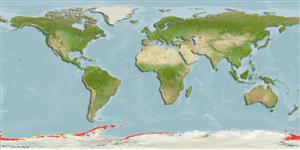Environment: milieu / climate zone / depth range / distribution range
Sinh thái học
Biển Sống nổi và đáy; Mức độ sâu 20 - 900 m. Polar; 60°S - 78°S
Southern Ocean: Circum-Antarctic on the continental shelf and slope.
Bộ gần gũi / Khối lượng (Trọng lượng) / Age
Maturity: Lm ? range ? - ? cm
Max length : 56.0 cm TL con đực/không giới tính; (Ref. ); Khối lượng cực đại được công bố: 1.1 kg (Ref. 124149)
Adults feed mainly on fishes and krill (Ref. 5200).
Iwami, T. and K.-H. Kock, 1990. Channichthyidae. p. 381-389. In O. Gon and P.C. Heemstra (eds.) Fishes of the Southern Ocean. J.L.B. Smith Institute of Ichthyology, Grahamstown, South Africa. 462 p. (Ref. 5200)
IUCN Red List Status (Ref. 130435)
Threat to humans
Harmless
Human uses
Các nghề cá: không ích lợi (thú vị)
Các công cụ
Special reports
Download XML
Các nguồn internet
Estimates based on models
Preferred temperature (Ref.
123201): -1.8 - 1.1, mean -1 °C (based on 533 cells).
Phylogenetic diversity index (Ref.
82804): PD
50 = 1.0000 [Uniqueness, from 0.5 = low to 2.0 = high].
Bayesian length-weight: a=0.00155 (0.00083 - 0.00287), b=3.39 (3.23 - 3.55), in cm total length, based on LWR estimates for this species & (Sub)family-body (Ref.
93245).
Mức dinh dưỡng (Ref.
69278): 3.4 ±0.48 se; based on food items.
Thích nghi nhanh (Ref.
120179): Trung bình, thời gian nhân đôi của chủng quần tối thiểu là 1.4 - 4.4 năm (Assuming Fec < 10,000).
Fishing Vulnerability (Ref.
59153): Moderate vulnerability (42 of 100).
Climate Vulnerability (Ref.
125649): High to very high vulnerability (73 of 100).
Nutrients (Ref.
124155): Calcium = 19.8 [10.9, 42.6] mg/100g; Iron = 0.361 [0.157, 0.739] mg/100g; Protein = 16.7 [15.0, 18.4] %; Omega3 = 0.234 [0.111, 0.492] g/100g; Selenium = 24.4 [8.8, 59.2] μg/100g; VitaminA = 18.8 [4.0, 91.5] μg/100g; Zinc = 0.419 [0.274, 0.638] mg/100g (wet weight);
